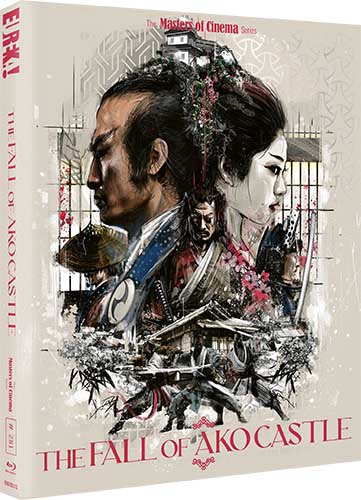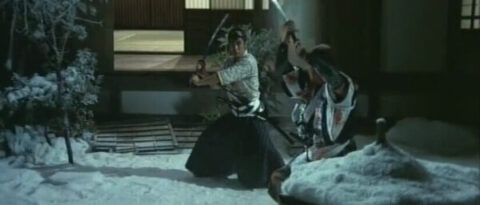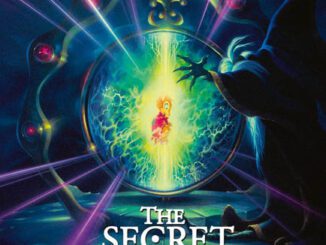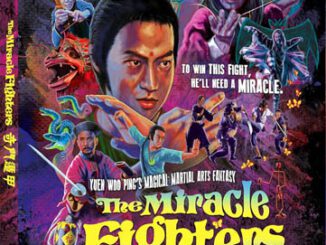The Fall of Ako Castle (1978)
Directed by: Kinji Fukasaku
Written by: Koji Takada
Starring: Kinnosuke Nakamura, Shin'ichi Chiba, Toshirô Mifune, Tsunehiko Watase
AKA AKO-JO DANZETSU, SWORDS OF VENGEANCE
JAPAN
AVAILABLE ON BLU-RAY: NOW, from EUREKA ENTERTAINMENT
RUNNING TIME: 158 mins
REVIEWED BY: Dr Lenera

It’s the time of the Tokugawa shogunate, and Lord Tsunayoshi has stripped lots of samurai of their status and wealth. When court official Kira insults Asano, one of the deposed samurai, Asano attacks him and is sentenced to committing suicide while all of his property is seized. Loyal retainer Oishi wants revenge, but because the target of his vengeance is protected by the shogunate, any retaliation would be seen as an act of treason, while Kirra is just so hard to get at, so he get together the rest of the ronin [masterless samurai] and the 47 of them pledge a blood oath to avenge their slain lord. Oishi bides his time, but not everyone is so patient….

The Revenge of the 47 Ronin, also known as the Aki Incident or the Aki Vendetta, was a real historical event in Japan in which a band of ronin avenged the death of their master on 31 January 1703. The incident became legendary, seen as emblematic of the loyalty, sacrifice, persistence, and honour [called “bushido” by the samurai] that Japanese people should aspire to and display in their daily lives. It’s then perhaps no surprise that it’s been adapted on various formats a huge number of times. Unless they really are very knowledgeable about Japanese cinema and/or Japanese history, most Westerners are most likely to know the tale, if they know it at all, from the Keanu Reeves-starrer 47 Ronin, which was a highly fantastical variant. The two best known Japamnese adaptations are the two-parter Genroku Ch?shingura, directed in 1941, by Kenji Mizoguchi no less, and 1962’s Chishingura, which like this film also featured Toshiro Mifune. Aside to being another film from the very diverse Kinji Fukasaku [Battles Without Honour And Humanity, Battle Royale], the chief allure for me was that it has both Mifune and Sonny Chiba in it, though their charaxters don’t actually meet, Mifune’s role is tiny [though important] and Chiba’s isn’t very large either, though then again his character is entirely fictional and was clearly added for box office. I haven’t seen either of those two versions but, based on my possibly limited understanding of the actual events, this one seemed to be a pretty good filming of the tale, though I did wonder if it may have been better if it had focused on more of the ronin than the two it does. Nonetheless it’s a leisurely but involving piece, surprisingly emotional in places, which gradually builds to a lengthy action climax, while Fukasaku films the majority of it in a stately style typical of the traditional samurai drama, only going for a frenetic vibe with the action sequences.
Narration gives us some background. Lord Tsunayoshi really did do his best to weaken the samurai, with 48 “lordly houses” falling and over 30 ooo samurai losing their status. We’re told that there was no proper rebellion, which is quite astionishing really. The titles take place over shots of people bowing their heads as low as posssible and the preperation for a ceremony where an official from the court will present Tsunayoshi with the Imperial Sword. The arrogant Kira can’t stop jibing at poor Asano, one of the many deposed samurai. “He knows nothing”, “rather slow learner or just not sharp enough”, “I always wonder if he’s going to embarrass himself”, “he’ll be a disaster if he embarrasses himself before the messenger”. After the last comment Asano can’t take any more and, despite such an act being a terrible offence, attacks Kira, slashing him in the face with his sword, and pandemonium erupts. Kira is taken to safety while Asano is is in trouble and his brother spreads the word on what he’s . Granted, Kira could have attempted to fight off his attacker, but he’s told that he was doing the right thing in not doing so and insists that he didn’t provoke Asano, while Asano, knowing perhaps what fate awaits him, expresses regret that he “wasn’t skillful” enough to kill him”, “the tip of the sword, it was three inches too short, I wish I’d killed him”. Asano’s retainer Kataoke begs for further investigation but is turned down, so seppuku, aka ritual suicide, it is. The sadness of the situation is milked considerably; usually we’d expect such an act to be presented rather coldly. Poor Asano slowly enters the precise tableaux of the courtyard and a few men where he has to do the deed, with pink blossom trees on the left emitting just a few falling flowers, while inside we have the servant asking to see his master one more time, and the sobbing wife, though the act itself isn’t shown at all.
Asano’s land and property are seized by the shogunate, the Asano name is abolished, and Lady Asano becomes a nun, while Kira is asked to resign. For some considerable time all this is handled in quite a methodical fashion. Asano’s home town of Ado doesn’t get to hear the news for some time, and then there’s much mourning amidst the presentation of Asano’s last letter and even his last poem which is read out in a touching moment, though is all the crying a bit over the top? Considering the ritualistic nature of so much that we see, perhaps not. Maybe more importantly, is all this too slow-going? I didn’t find it to be so, in fact I could have done with a little bit more of explaining of some of the political stuff surrounding the main situations. I’m still not sure of the exact roles of at least two characters. Anyway, quite a lot of the ronin want revenge right now, but Oishi says “we can’t decide immediately”. More people turn up to help them, along with some others from the Asano clan seeking shelter because any Asano will now be punished if found, Oishi is ordered to give up his castle, but won’t do so even though he’s told that his position is stupid and that surrender is the only option. Some folk leave, others commit suicide. Months pass and there’s a new Lord, Yanagisawa, who’s a bit nicer than his predecessor and grants Oishi a fiefdom. Hashimoto and Horibe of the Asano clan hastily choose to ambush Kira, who’s just retired, but are stopped by spies and other members of their clan and Hashimoto is injured, the start of some serious decline for him. As for Oishi, he divorces his wife and begins to sink into drinking and whoring. When’s this blasted attack actually going to be?

Now you’re probably most wondering where Chiba is in all of this. He plays Fuwa, a swordsman who isn’t allowed inside the Asano castle because he killed someone and angered Oishi – and that’s the most we get to know. Fuwa is introduced being asked by Oishi’s older, 14-year old son to teach him how to commit harakiri, his classic response being “well I’m afraid I don’t have experience killing myself“, then gets to do some training in a bamboo forest and make things out of paper for Oishi’s other two kids, though it’s still some time before he gets to engage in any action. The shooting style of The Fall Of Edo Castle is generally sedate with lots of lingering compositions, long takes and a very steady camera, but the first time we have some fighting, a scene that’s accompanied by an elderly lady singing in a atrange but nice touch, it goes all shakycam. Successive bursts of violence, two of which also feature Chiba and one which takes place in the rain, aren’t quite as wobbly but still provide a contrast to the way everything else is filmed, and as with Fukasaku’s many gangster movies there’s a messy quality to the action. However, the very lengthy final battle does feature some moments that contain precise staging, most notably when Chiba cuts loose against multiple opponents before dueling with Genroku Chisingura all over the castle in a slightly longer two-person encounter than we’re used to in chambara films. However, what may stick with you far longer are three other things. First of all we see Fuwa really worn out after cutting loose, as indeed he would be. Secondly, there’s the slightly offhand way in which the main act of revenge is carried out. And thirdly there’s the coda which will deeply sadden those who don’t know the story; actually, considering the emotionally intense way it’s done, it’ll also deeply sadden those who don’t.
Fukasaku and his familiar-for-the-period screenwriter Koji Takada, don’t seem too interested in the intrigues and politics of what is probably a very complex tale. Some of this material seems rushed. Mifune’s character Lord Tsuchiya is only in three scenes yet he seems to be very important. Om the other hand there’s a lot of emphasis on the emotional states of Oishi and Hashimoto, and the toll that all this waiting takes on them. Both become decidedly unsympathetic for a while, Hashimoto’s harsh treatment of his wife perhaps being the nadir, and there’s tragedy in line for both characters. Is it a flaw that we never really learn why Oishi waits for a year and a half to carry out his vengeance. Yes, the final attack takes place in a more vulnerable place than Edo Castle, but what if this opportunity hadn’t presented itself? How much longer would he have been willing to wait? The film seems surprisingly ambivalent on the issue, rather than claiming that Oishi was totally right and entirely honourable. Oishi is an interesting flawed hero, though Kinnosuke Nakamura’s acting can be seen to way over the top, in some respects like silent movie performing. But this was the usual style in such films, even in the ’70s, so can it be really regarded as a flaw? Masaomi Kondô as Hashimoto is even more exaggerated. On the other hand, is the fact that I’ve recently been watching some of Fukasaku’s yakuza films the only reason as to why most of the characters in this one seem to behave much like his yakuza?
The Fall Of Ako Castle simplifies the actual events a bit for clarity and occasionally stumbles in doing so, while the bits of narration are rather pointless because we can deduce what’s going on anyway. Nonetheless, never boring even in its most methodical passages, The Fall Of Ako Castle is a cracking samurai drama that’s also at times surprisingly moving.
SPECIAL FEATURES
Limited Edition O-Card slipcase featuring new artwork by Chris Malbon [2000 copies]
Presented in 1080p HD from a restoration of the original film elements by Toei
There’s some minor flickering plus a bit more grain in places than we’ve come to expect, in the early stages, though it shouldn’t be enough to distract, and it’s not long before the picture quality becomes extremely good indeed, with rich colours [the blood looks especially vivid], and plenty o depth to add to cinematographer Yoshio Miyajima’s already well put together compositions.
Uncompressed original Japanese Mono audio
Optional English subtitles
New feature-length audio commentary by critic Tom Mes
“I hope I make it to the end, I hope you make it to the end without getting bored with me” says Mes early on, and Mes does have a rather relaxing voice which may cause some listeners to nod off, but that’s not his fault, and he does continually provide commentary that’s of interest, beginning with saying that nobody really knows what Kira exactly said to cause Asano to draw his sword, followed by other facts about the true events. As well as also providing a lot of general detail such as there having been several different capital cities in Japan, the two most notable being Kyoto and Edo [Tokyo], Mes also tells us some that there was conflict between Fakusaku, who wanted to be experimental and even switch the casting of the main hero and villain, and Nakamura, and why black teeth is curiously common in such films. In his laid back way, Mes keeps the info coming and only takes longer breaks between talking towards the end.
Tony Rayns on The Fall of Ako Castle – new interview with Asian film expert Tony Rayns [41 mins]
Rayns, despite not sounding particularly admiring of Fukasaku’s work in general, not to mention calling 47 Ronin “an atrocity”, is on top form, less rambling than he sometimes is, just focusing on providing a huge amount of detail on the real events – according to him the reason for Kira’s insulting of Asano was that Asano didn’t pay a bribe to Asano which everyone else of his station did – while the ronin, just before their attack, warned the neighbours of what they were going to do. He also goes through many of the adaptations – apparently early ones had to slightly disguise the story because law forbade reenactments of recent political events – and we learn that modern-day, animated and even erotic versions were filmed. Paintings, footage from very early films and even shots of the actual graves of the ronin complement this fine piece.
King of my Castle – new video essay by author and critic Jasper Sharp [14 mins]
This seems rather too brief, and can’t help but retread ground covered before in the commentary and Rayns’s piece, but Clements does give us a nice summing up, and looks in more detail at the filming style, such as many shots cramming in lots of people as in many other Fukasaku movies.
Reversible sleeve
A collector’s booklet featuring a new essay on the film by Jonathan Clements and a filmography of works by Kinji Fukasaku
Eureka bring out another fine samurai picture with added insight from some of the best in the business. Highly Recommended!







Be the first to comment